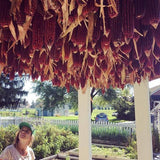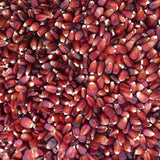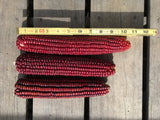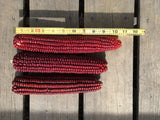Bloody Butcher Corn
Zea mays
Stalks grow to 10'-12' tall producing at least two large ears of deep red dented kernels, with occasional blue or gold kernels. Makes tasty pink cornmeal and grits. Some of the longest and fattest ears I've ever grown! A relatively soft dent corn traditionally used for cornmeal, grits, and stock feed. I've always been told it has deep roots in Virginia and Western North Carolina, where it is popular with the old timers and said to have been grown since the mid-1800s. The seed I received had been grown on the same land I grew it on for at least 10 years. That seed was acquired from a fellow draft horse farmer in Henderson County, NC.
Days to maturity: 90
Seeds per pack: 60
Germination rate: 97% on 02/24/2021
Planting / harvesting notes
Direct seed about an inch deep in moist soil a couple weeks after the last danger of frost. 12"-24" spacing in row, especially if inter-cropping with beans and/or squash. Needs full sun and ample nitrogen in well-drained soil. Ears can be harvested in the milk stage for roasting when the silks have turned dark and withered yet the husks are still green. Leave ears on the stalks as long as possible to dry before harvesting for milling or seed. If weather and/or pests prevent a full cure on the stalk, wait until the ear has flopped over, silks toward the ground, making sure the husks are brown and papery.
Seed keeping notes
Corn is wind pollinated and should be isolated by 2-3 miles from other varieties of corn to avoid unwanted cross-pollination. Another option is to separate your corn plantings by 3-4 weeks so they do not flower/tassel at the same time. Allow the husks and cobs to fully dry on the plants before harvesting for seed. If you are concerned about neighbor's corn plots hybridizing yours, consider only harvesting seed from the plants towards the middle of your plot, leaving the outer rows for eating. If necessary, lay out the cobs to do some final drying before removing the husks and seeds.
Second photo is of Becca Munro with her Bloody Butcher crop drying down at the Kitchen Garden of the Pennsylvania German Cultural Heritage Center in Kutztown, PA.











